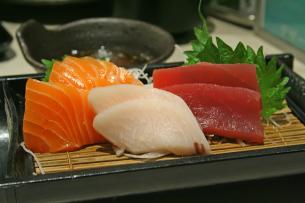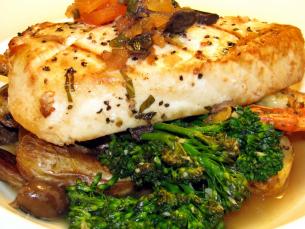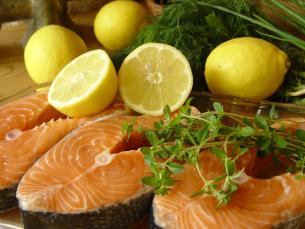
A sashimi plate that includes (from left) salmon, swordfish and tuna – a range of fish texture and color.
Choosing what fish to cook for dinner is a lot harder than actually cooking the fish! Here is a quick guide that will help you sort out the different cuts and how to prepare them.
Fat Content of Fish
Fish can be subdivided into three groups based on their fat content. The higher the fat content , the richer the taste. (No surprises there!)
Lean fish typically have about 2 per cent fat content. Some examples are: cod, turbot, haddock, halibut, brook trout, red snapper, hake and tile fish.
- Cooking Tip: poaching, steaming and pan-frying are good cooking methods for lean fish. This kind of fish tends to flake and fall apart when cooked, so it’s not a good candidate for barbecuing.
Medium-fat fish typically has around 6 per cent fat. Some examples are: swordfish, pompano, striped bass and bonito tuna.
- Cooking Tip: pan-frying is a good cooking method for many varieties of fish with a moderate fat content. These varieties can also be baked, broiled or grilled.
The fat content of high fat fish is typically around 12 per cent. Some varieties are: salmon, butterfish, grouper, herring and yellowtail.
- Cooking Tip: Grilling works well with higher fat fish, because it has rich flavor and holds together better than lower-fat varieties.
Whole, fillets or steak
When you’re at the fish counter, you’ll see that fish is available in several different forms:
- Whole: These have the heads and tails on and are probably best left to more experienced cooks.
- Fillets: These are usually boneless cuts that may or may not have the skin on. You can always ask to have the skin removed.
- Steaks: Steaks (shown below) are typically thicker cross-sections from the back of the fish, which have bone attached.
These salmon steaks contain part of the backbone.
Ways to Cook Fish
Microwaving Fish
These salmon fillets will take about five minutes to cook in a microwave oven.
The microwave is a great place to cook fish when you’re in a hurry. Cooking time will depend on the strength of your microwave and on the thickness of the fish. For reference, microwaving 2-inch-thick salmon steaks takes about 5 minutes. It’s better to underestimate than overestimate cooking times. Remember that fish will continue cooking for a few minutes even after it’s come out of the microwave. This demonstration of Cold Salmon with Creamy Mustard Sauce shows that you can get a head start on dinner by zapping the salmon for five minutes in the morning, then refrigerating it to eat later in the day. Salmon is delicious eaten hot or cold.
Baking Fish
Here are baked cod fillets with salsa.
This is another simple cooking method that works for almost any kind of fish. The rule of thumb is to cook it four or five minutes per half-inch of thickness, or eight to 10 minutes per inch of thickness. In this demonstration of baked cod with breadcrumbs, the thick fillets take about 25 minutes to cook. The fish can be seasoned, marinated or cooked in a sauce, as startcooking.com demonstrates in this preparation of Baked Cod with Salsa.
Pan Frying Fish
Pan-fried Kona Kampachi
Pan frying works with all kinds of fish, but especially with milder fish. It’s fine to use fish fillets that have a strip of skin on the side. Depending on the kind of fish you’re using, you may want to dredge or coat the fish in flour, for a crispy finish. This will also give a bit more flavor and substance to lean varieties of fish.
But there’s no need to dredge meatier kinds of fish. Startcooking.com’s tutorial on Pan-Fried Fish with Lemon and Parsley shows this simple and quick method. Fans of fish sticks won’t go near the frozen kind after trying our recipe for homemade fish fingers (shown below) – these are so easy and so out of this world!
Fish fingers get a coating of flour and breadcrumbs before being pan-fried.
Broiling Fish
When you set the oven to broil, the heat comes directly from above, browning the top of the fish nicely. Put the fish skin-side down on a broiling pan, or on foil-lined baking sheet four to six inches from the broiler. It can take anywhere from two minutes to 10 minutes to cook, depending on the thickness. If the fish is very thick, it may need to be flipped halfway through.
Poaching Fish
This is a good method for lighter, more delicate kinds of fish. The fish gets GENTLY simmered in liquid in a pan on the stove for a few minutes. The key is not to let the liquid boil because this will cause the fish to come apart. Cooking For Engineers offers a very helpful tutorial on poached fish.
Fish in foil or parchment (en papillote)
Fish en papillote may sound like a fancy cooking method, but it’s actually one of the easiest ways to cook your whole meal all in one go! You simply place your fish, with some chopped vegetables, on foil or parchment paper, then fold the foil/paper over the ingredients and close up the edges so that it’s like a sealed packet. Cook at 400F for 15 to 20 minutes — the steam inside the packet cooks the food.

The meaty texture of swordfish does well on the grill.
Grilling Fish
Our post on Grilling Fish 101 covers the basics of cooking fish on an outdoor grill. In short, grilling works best on thicker, fattier fish like salmon, swordfish, mahi mahi and tuna. Although you can grill leaner, flakier fish, you’ll need to use a fish basket or grill it on foil.
If you are still having difficulty choosing fresh fish and seafood, just ask the person at the fish counter for some advice.
Happy fishing!!
If you are new to startcooking, or are a regular visitor here, please consider subscribing for free.









































outdoor griller said:
That sounds good!
I like to make a foil pouch and put them on the grill.